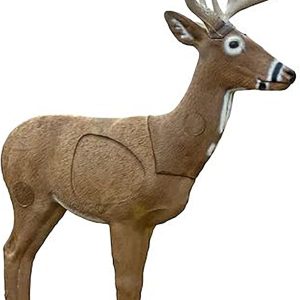3D Archery Targets
Shooting dots and bullseyes is fine for building form. But at some point you need to practice on something that actually looks like what you’re hunting.
3D targets are life-size foam animals with vital zones marked for scoring. Deer, elk, bears, turkeys, coyotes, javelina – if people hunt it, someone makes a foam version. The good ones have realistic shading and anatomy so you’re not just guessing where the lungs are.
Why shoot 3D? Because a whitetail standing quartering-away at 35 yards doesn’t look like a yellow circle. You need to learn shot angles, where to aim on different body positions, and how to pick a spot on hair instead of a target ring. 3D shoots force you to range unknown distances, deal with uphill and downhill angles, and make the same decisions you’ll make in the woods.
Scoring zones are printed on the vitals – usually a 12-ring (heart), 10-ring (lungs), 8-ring (vitals), and 5-ring (body hit). Competitive 3D shooters chase 12s. Hunters just want to consistently hit vitals from field positions.
Foam quality matters. Cheap targets fall apart after a few dozen shots. Rinehart, Delta McKenzie, and Field Logic make targets that survive thousands of arrows. Self-healing foam closes up around holes instead of tearing and separating. Replaceable cores let you swap out the vitals when they get shredded without buying a whole new target.
Full-size targets are expensive – $100 to $300+ for a single deer. But they last years if you don’t shoot the same spot repeatedly, and they’re the best training tool for hunters who actually want to make ethical shots in the field.
Most clubs run 3D leagues spring through summer. Twenty to thirty targets set up on trails through the woods at unmarked distances. It’s the closest practice you’ll get to real hunting without actually hunting.
Showing the single result
-
3D Archery Targets
Rinehart Woodland Deer 3D Target
$234.53Life-size 3D deer target with replaceable vitals. Realistic practice for bowhunters training shot placement.

